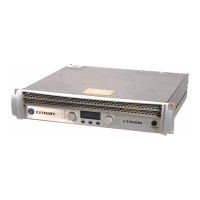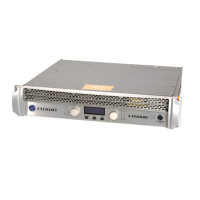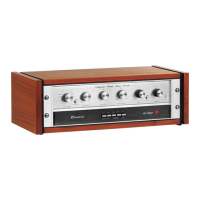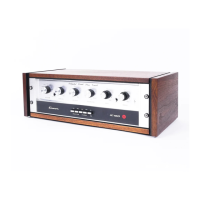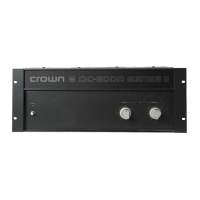Operation Manual
I-Tech HD Series Power Ampliers
page 10
I-Tech HD Series Power Ampliers
Operation Manual
page 11
Figure 2.14
Wiring a Speaker in Bridge-Mono Mode to
the Top Speakon
®
Connector
Table 3
Top Speakon
®
Wiring for Bridge-Mono
PIN 1+ 2+
SPKR
+ –
2 Setup
2.3.5 Bridge-Mono Mode
Overview: Turn on the amp, enable Bridge-Mono mode using the LCD Control
Screen, turn off the amp, wire it, and turn it back on.
1. Be sure that no cables are connected to the amplifier. Turn on the front-panel power
switch. The LCD Control Screen will light up (Figure 2.12).
2. Under the LCD Control Screen, press the Menu/Exit button. Press the Next
button until you see OUTPUT MODE on the screen. If N/A is displayed, OUTPUT
MODE is locked via software. If LOCKOUT is displayed, all the LCD screens are
locked via software.
3. Press an Encoder knob to select BRIDGE MONO. Press the knob again to confirm
your choice. Press Menu/Exit. Turn down both level controls (Encoders) until you
reach maximum attenuation.
4. IMPORTANT: Turn off the amplifier and unplug its power cord.
INPUTS: There are three ways to connect an input signal to the amplifier (Figure
2.13):
• Connect an analog signal source to the Channel-1 amplier input.
• Connect an AES/EBU digital signal source to the Digital Input IN connector.
NOTE: Crown provides a reference of wiring pin assignments for commonly used
connector types in the Crown Amplifier Application Guide available at
www.crownaudio.com.
OUTPUTS: Use Class 2 output wiring. There are two ways to wire the amplifier output
connectors for Bridge-Mono mode:
1) Wire the speaker across the red binding post of each channel (Figure 2.14). Do not
use the black binding posts when operating in Bridge-Mono mode.
2) Wire the speaker only to the top Speakon
®
connector as shown in Table 3 and
Fig ure 2.14.
Figure 2.12
The LCD Control Screen
NOTE: In Bridge-Mono
mode, the Channel 1
Level control sets the
level; the Channel 2 Level
control is defeated. All
Channel-2 objects and
controls are hidden and
disabled.
3.2 Startup Procedure
When first turning on your amplifier, follow the procedures in the
Quick-Start Guide on page 4 (stereo) or page 5 (bridge-mono).
If you ever need to make any wiring or installation changes, don’t for get
to disconnect the power cord.
For help with determining your system’s optimum gain structure
(sig nal levels) please refer to the Crown Amplifier Application Guide,
available online at www.crownaudio.com.
3.3 Precautions
Your amplifier is protected from internal and external faults, but you
should still take the following precautions for optimum performance
and safety:
1. Before use, your amplifier first must be configured for proper
operation, including input and output wiring hookup. Improper
wiring can result in serious operating difficulties. For information
on wiring and configuration, please consult the Setup section of
this manual or, for advanced setup techniques, consult Crown’s
Amplifier Application Guide available online at
www.crownaudio.com.
3 Operation
3.1 Protecting Your Speakers
It’s wise to avoid clipping the amplifier signal. Not only does clipping
sound bad, it can damage high-frequency drivers. To prevent clipping,
use System Architect software’s Level Max suite to enable or display
the peak voltage limiter and average power limiter in your amplifier’s
built-in DSP. That way, no matter how strong a signal your mixer
produces, the amplifier output will not clip. Set the limiter threshold so
that mixer signals above 0 dB or 0 VU on the mixer meters do not quite
drive the amplifier into clipping.
Also, avoid sending strong subsonic signals to the amplifier. High-
level, low-frequency signals from breath pops or dropped micro-
phones can blow out drivers. To prevent subsonic signals, use one of
these methods:
• Insert a highpass lter between mixer output and amplier input (or
between mixer and limiter).
• Use the I-Tech’s onboard DSP to set up a highpass lters.
• Switch in highpass lters at your mixer. Set the lter to as high a
fre quency as possible that does not affect your program. For example,
try 35 Hz for music and 75 Hz for speech. On each mixer input channel,
set the filter frequency just below the lowest fundamental frequency of
that channel’s instrument.
2. Use care when making connections, selecting signal sources and
controlling the output level. The load you save may be your own!
3. Do not short the ground lead of an output cable to the input signal
ground. This may form a ground loop and cause oscillations.
4. WARNING: Never connect the output to a power supply,
battery or power main. Electrical shock may result.
5. Tampering with the circuitry, or making unauthorized circuit
changes may be hazardous and invalidates all agency listings.
6. Do not operate the amplifier with the red Clip LEDs constantly
flashing.
7. Do not overdrive the mixer, which will cause clipped signal to be
sent to the amplifier. Such signals will be reproduced with extreme
accuracy, and loudspeaker damage may result.
8. Do not operate the amplifier with less than the rated load
imped ance. Due to the amplifier’s output protection, such a
configura tion may result in premature clipping and speaker
damage.
9. CAUTION – SHOCK HAZARD: Potentially lethal voltages
exist at the output connectors when the amplifier is
turned on and is passing a signal.
Remember: Crown is not liable for damage that results from
overdriv ing other system components.
Menu/Exit Prev Next
Figure 2.13 Bridge-Mono Wiring to Binding Posts
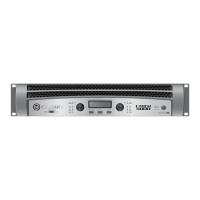
